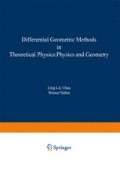Abstract
In statistical mechanics one is interested in the globally observable properties of a system with an enormous number of degrees of freedom. One approach to the analysis of such systems is to define simplistic mathematical models which can be calculated exactly. The first example is the Ising model, solved by Onsager in 1944. A state of the system is defined by a configuration of + and − signs (spins) at the vertices of a square lattice in the plane. Each edge of the lattice is to be thought of as an interaction and contributes an energy E(σ, σ′) to the total energy where σ, σ′ are the spins at the ends of the edge.
Access this chapter
Tax calculation will be finalised at checkout
Purchases are for personal use only
Preview
Unable to display preview. Download preview PDF.
References
J. Alexander.
R. Baxter, “Exactly solved models in statistical mechanics”, New York Aca demic Press, 1982.
J. Birman, H. Wenzl “Braids, link polynomials and a new algebra”, Trans. AMS (to appear).
V. Drinfeld “Quantum groups”, Proc. ICM, 1986.
V. Fateev and A. Zamolodchikov, “Self-dual solutions of the star-triangle relations in ƵN models”, Phys. Lett. 92A, 37–39 (1982).
D. Goldschmidt and V. Jones “Metaplectic link invariants”, Geometric Dedicata (to appear).
M. Jimbo, “Quantum R-matrix for the generalized Toda system”, Comm. Math. Phys. 102, 537–547 (1986).
T. Kobayashi, H. Murakami, J. Murakami, “Cyclotomic invariants for links”, Proc. Japan Acad., 235–238 (1988).
E. Witten, “Gauge theories an integrable lattice models”, IAS Preprint, 1989.
Author information
Authors and Affiliations
Editor information
Editors and Affiliations
Rights and permissions
Copyright information
© 1990 Springer Science+Business Media New York
About this chapter
Cite this chapter
Jones, V.F.R. (1990). Baxterization. In: Chau, LL., Nahm, W. (eds) Differential Geometric Methods in Theoretical Physics. NATO ASI Series, vol 245. Springer, Boston, MA. https://doi.org/10.1007/978-1-4684-9148-7_2
Download citation
DOI: https://doi.org/10.1007/978-1-4684-9148-7_2
Publisher Name: Springer, Boston, MA
Print ISBN: 978-1-4684-9150-0
Online ISBN: 978-1-4684-9148-7
eBook Packages: Springer Book Archive

